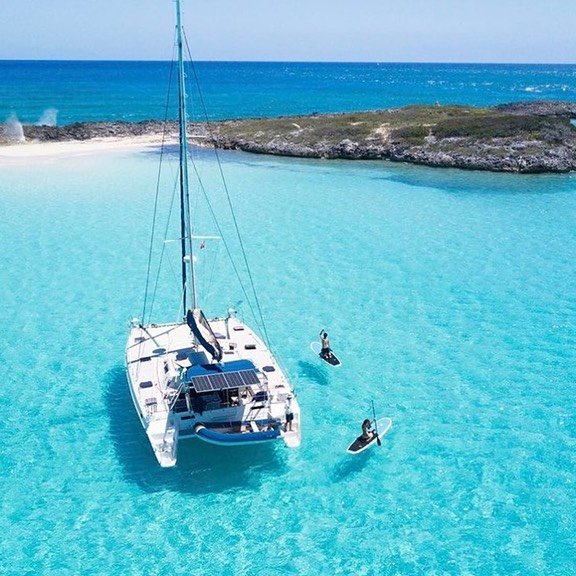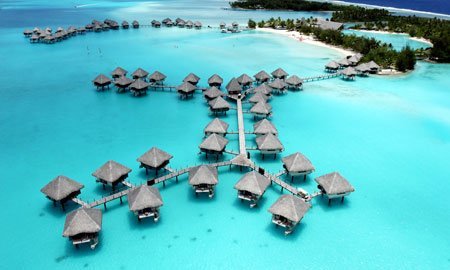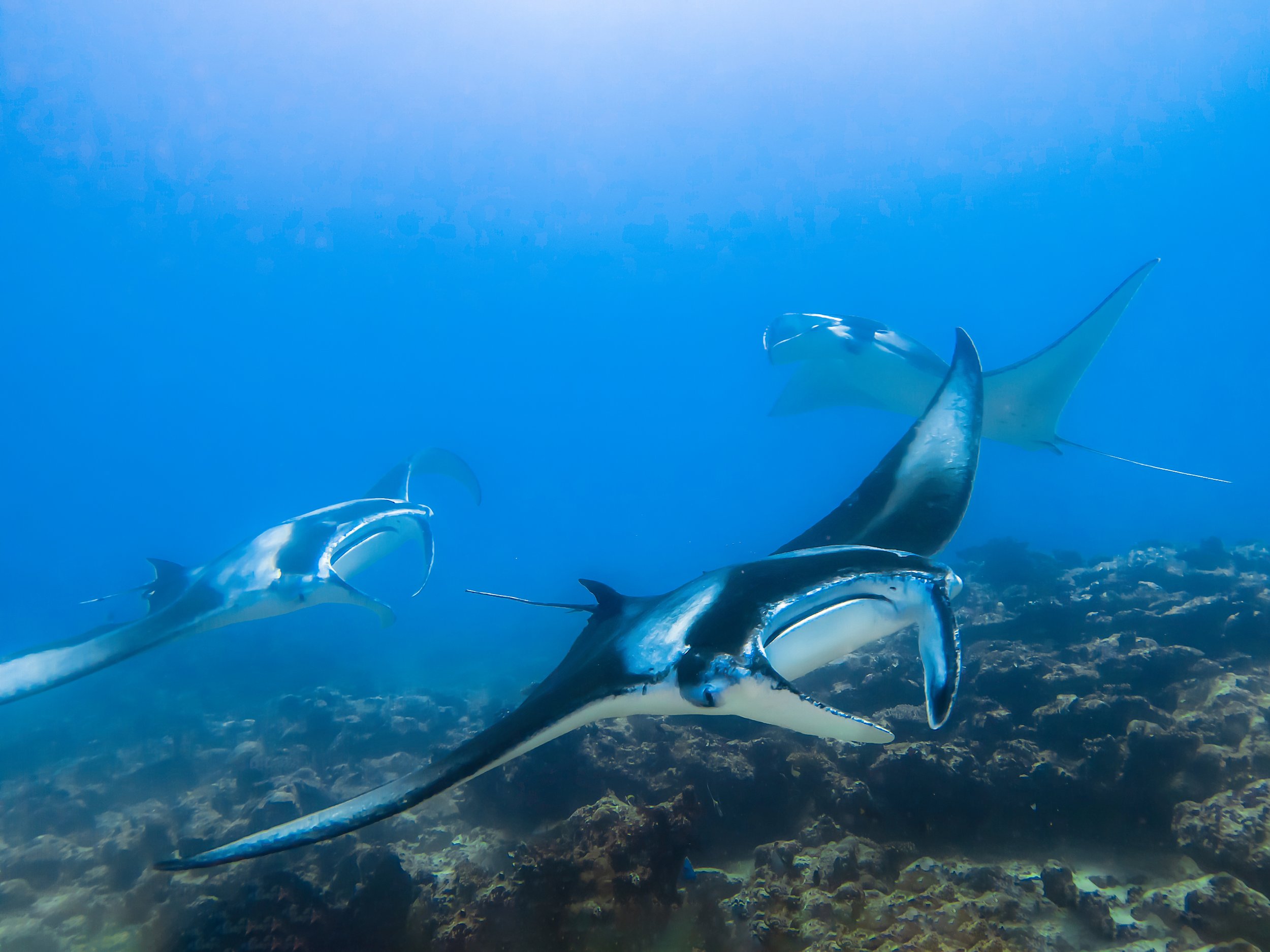
SOCIETY ISLANDS
+
BORA BORA
8 days / 7 nights.
A Tahiti sailing expedition includes easy passages within the protected waters behind the beautiful coral reefs that encircle the islands, allowing for relaxed sailing in one of the most exotic cruising grounds in the world. Snorkeling and freediving on the reefs, swimming and sunbathing on white-sand beaches, and spending quiet evenings aboard our yacht in picturesque anchorages are all part of what makes sailing in French Polynesia so appealing. The open-water passages downwind from Huahine to Tahaa and from Tahaa to Bora-Bora are simply spectacular, South Pacific sailing at its very best.
ITINERARY
Subject to change due to weather / animal behaviour
DAY 1
Fly into Raiatea Airport (RFP) from Papeete (PPT), French Polynesia on the morning of Day 1. Taxi to the marina where we will meet up with the rest of the crew and complete our final grocery shopping & provisioning. We take possession of the catamaran at 2pm and depart the marina that same day.
From Raiatea, we sail to Taha’a - where we will spend the night at anchor next to the coral gardens.
DAY 2
We begin the day at the coral gardens - the most renowned snorkeling spot of Taha’a. This crystal clear water channel, which separates two motus, is in the middle of one of the largest lagoons of Polynesia. While let yourself drift over colorful and preserved corals, you will see schools of butterflyfish, lionfish, brightly colored wrasse, clownfish huddled in their anemones and great giant clams sunbathing right under the surface of the sea.
DAY 3
First thing in the morning, we sail from Taha’a to Bora Bora where we will visit the Manta Ray cleaning station. The mantas come to be dewormed by the cleaner wrasses that live in the corals.
We can observe the Manta rays which sail between two coral reefs. We can also meet other marine animals lie turtles, black tip sharks, eagle rays, sting rays and a ton of tropical fish.
DAY 4
As we sail around the island of Bora Bora, we will see various types of tropical fish, black tip sharks turtles, and bottle nose dolphins.
The depth varies from a few feet near the reef to hundreds of feet in the channel.
DAY 5
We will begin the day with the intention of finding humpback whales west of Bora Bora - weather permitting. If conditions outside the lagoon aren’t ideal, manta rays, stingrays and black-tip reef sharks are just some of the treasures to be found around the gorgeous lagoons of Bora Bora.
Enjoy plenty of snorkeling opportunities plus a delicious barbecue lunch at a private island. You’re treated to French Polynesian hospitality and entertainment, topped by incredible photo ops from the island summit.
DAY 6
Once again, our priority is finding wildlife. We will snorkel through a coral garden, where we can discover the wonderful natural ecosystem. The afternoon can be spent visiting the sting rays and black tip reef sharks in shallow water, a unique experience. That afternoon, a Polynesian lunch will be served on a private island (motu). The menu will include fish, chicken, shrimp, Polynesian vegetables, raw fish salad with coconut milk, coconut rice, Tahitian bread and tropical fruits.
DAY 7
Weather permitting, we will spend the morning in search of eagle rays, mantas, and black tip sharks. That afternoon, we will sail back to Taha’a and enjoy the beautiful scenery. In the evening, we will experience a traditional Polynesian Barbecue with traditional hula and fire dancing as well as a buffet of delicious local fish, pineapples, coconuts, sweet potatoes, and salads.
DAY 8
Our final day. At first light, we will sail back to Raiatea where we will refuel the catamaran and disembark. Plan to book your return flights back to PPT and then home from after 11am.
HIKING ON BORA BORA
There are several hikes on Bora Bora.
Mount Otemanu: best for bragging rights (~ 6 hours return, difficult)
Mount Pahia: best views of the island (~ 6 - 8 hours return, difficult)
Valley of The Kings: most popular hike (~ 3 hours, easy to moderate)
A local guide is recommended due to the lack of signage, overgrown tracks, and the mountainous nature of the trails.
ARRIVAL & DEPARTURE
Papeete (PPT) is the capital of French Polynesia and is the international airport you will fly into. Once in Papeete, you will need to take another flight to Raiatea Airport (RFP) anytime in the morning on Day 1.
The catamaran is located 5 minutes from Raiatea Airport.
After arriving in Raiatea, take a taxi to Uturoa Marina. We’ll be waiting for you.
Plan to arrive at Raiatea Airport (RFP) on the morning of Day 1 - Saturday. Your departure flight from Raiatea Airport (RFP) should be after 10am on Day 8 - Saturday.
EXPEDITION HQ
THE LAGOON 52 CATAMARAN
The Lagoon 52 catamaran will be the main control centre during the expedition. A versatile boat - perfect for exploration, speed, and comfort. Six cabins, air conditioning, six full heads, sleeps 14, stove, fridge, hot water. Plenty of deck space to lay out on too.
This luxury catamaran represents the impeccable craftsmanship and timeless elegance that are hallmarks of Lagoon. The Lagoon 52 carries itself with the air of luxury and seaworthiness that is inherent in every sailing yacht. Premium performance, precision handling and gracious livability.
FREEDIVING
You’ll have an opportunity to learn the basics of freediving and become an autonomous freediver - able to explore the underwater world comfortably.
Practice freediving safely, and learn what happens with your body when you hold your breath, how to dive more efficiently, how to handle freediving mentally, and how to hold your breath longer.
COSTS
Every sailing journey we plan is as unique as your group, with pricing customized according to your chosen dates and specific preferences, all designed to provide an unparalleled expedition experience. Reach out for a quote.
INCLUDED:
Shared Accommodation in a double cabin on a catamaran
8 days on the water (7 full days & 1 half day)
Catamaran based excursions and freediving
An experienced captain
Mask, Fins & Snorkel
Digital copies of photos from the trip
Fresh linens & Catamaran cleaning
Catamaran charter, Catamaran Insurance, Port & Charter Taxes, Damage Waiver, Society Islands Cruising Permit, French Polynesian Eco-Tax
NOT INCLUDED:
Airfare to and from Tahiti (PPT) and Raiatea (RFP)
Hotels / Taxi
Shore Excursions
Personal Expenses
Gratuity for boat captain
Travel Medical Insurance (Required)
Food, snacks, drinks on the catamaran
Polynesian BBQ and Fire Show
Fuel & Mooring Fees
ESTIMATED VARIABLE COSTS:
Food Provisioning - $200pp (estimated for 1 week)
Fuel - $40pp (estimated for 1 week)
Upon arrival in Raiatea, we will shop for groceries and provision the catamaran for the week. Most meals will be aboard the boat, however there are a few of restaurants around Bora Bora including the world famous Bora Bora Yacht Club.
We will divide the variable costs throughout the trip using the Splitwise app and settle up at the end of the week.
DEPOSIT & PAYMENT
Non-Refundable Deposit of $1000 to reserve spot
Balance is due 60 days prior to expedition
To secure your spot, send your deposit via ACH / wire transfer or credit card
RESOURCES
Download Splitwise App
Download WhatsApp
Download Navionics
COVID-19 PROTOCOLS
All information related to entry requirements can be found at on the French Polynesia Government Website.
Travelers no longer have to complete any health formality before their arrival in The Islands of Tahiti, in France or overseas, and the presentation of the health pass/proof of full vaccination schedule is no longer required, whatever the country or area of origin.
Must have a valid passport for a minimum of three months after the return date to enter French Polynesia.
No visa required.
INSURANCE
It is strongly recommended to carry Extended Medical Insurance, Emergency Evacuation Insurance, and Trip Cancellation Insurance.
WEATHER
The superb weather in French Polynesia in August and September sees an average daytime high temperature of 26°C. The moderate ocean breeze will help to keep you fresh. At night, the temperature will fall to around 22°C. The humidity and the UV levels are high, so use plenty of sunblock and carry water when you’re out in the daytime sun. Showers are expected across 5 wet-weather days around the French Polynesia in February. You’ll want to make the most of the sunshine in the tropical Pacific climate. There’ll be about eight hours each day, on average, and the sun doesn’t set until nearly 7pm. The water temperature will be an incredible 28°C.
Questions?
Let’s talk!



















































